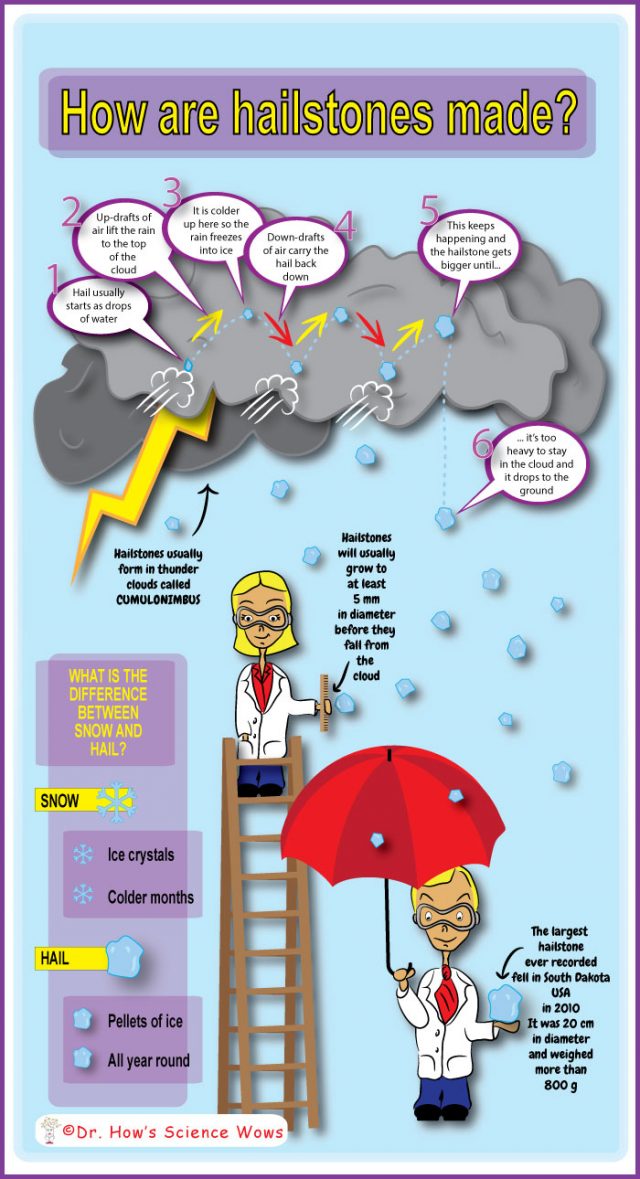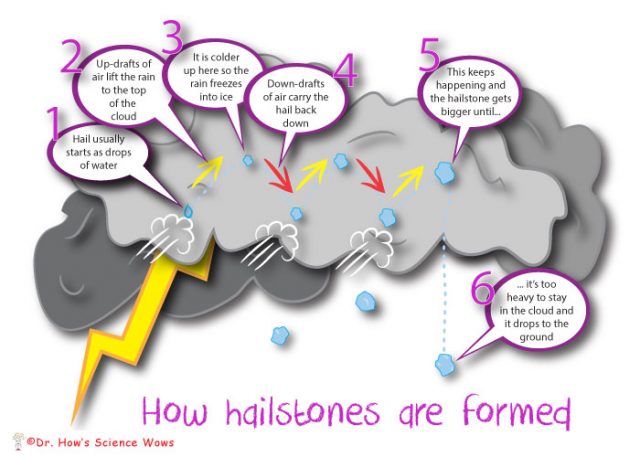The simple science twins are back to answer more of your questions; this one is all about hailstones and it comes in from five year old Matthew who can sometimes be found over on Office Mum’s blog. Matthew would like to know…
What are hailstones and how are they made?

What are hailstones?
Hailstones are small lumps of ice that form in the clouds and fall to the ground when their size reaches 5 mm in diameter, or larger.
They begin as water droplets that freeze in the clouds.
How are they made?
Hailstones are made in certain kinds of clouds, called CULUMONIMBUS. These are thunder clouds and if the cloud is large enough and the winds are strong enough, hailstones can be formed.
Firstly, the cloud contains tiny droplets of water. Under the right conditions, these droplets are blow to the top of the cloud by strong winds, called UP-DRAFTS. The temperatures at the top of the cloud are a lot lower than at the bottom so the water droplets freeze rapidly. Then they can be caught by winds, called DOWN-DRAFTS that carry the frozen droplet back down to the lower part of the cloud. It gets lifted again, by another up-draft and combines with another droplet of water, which freezes, forming a larger lump of ice.

Every time it travels up to the top of the cloud it merges with more droplets and gets larger, freezing in layers, until eventually it is too big and heavy to stay in the cloud and it falls to the ground as hail.
Hailstones usually fall once they are larger than 5 mm in diameter.
The size of the hailstones depends on the up-drafts and down-drafts and the general weather conditions. When the up-drafts become stronger the thunder clouds grow taller, allowing the droplets to be carried higher into colder temperatures. This usually leads to larger hailstones.
The largest hailstone ever recorded was 20 cm in diameter and weighed 0.88 kg. It fell in Vivian, South Dakota, USA on July 23rd, 2010.
What is the difference between snow and hailstones?
Hailstones are made up of layers of frozen ice whereas snow is a symmetrical crystal of ice, usually a snowflake.
Hailstones are much heavier than snowflakes and fall at a greater speed.
Snow is usually formed during the colder months of the year, in Winter or Spring whereas hailstones can be made at any time of the year. That is why we sometimes get them in the Summer months.
Thanks so much to Matthew for sending in this great question. If you have a question that you’d like the simple science twins to answer, send it in to me at drhowsciencewows@gmail.com or leave it in the comments below.
Hi Naomi, I have a Grandson coming to visit this week and it seems likely that we will either have hail or snow so I’m looking forward to showing him this post and we can learn together 🙂
I think you are right about the hail or snow Miriam! I hope your grandson likes this post 🙂
I’m so delighted to see this and can’t wait to show him – he’ll be delighted!
Great! and thanks so much to Matthew for sending in his question!